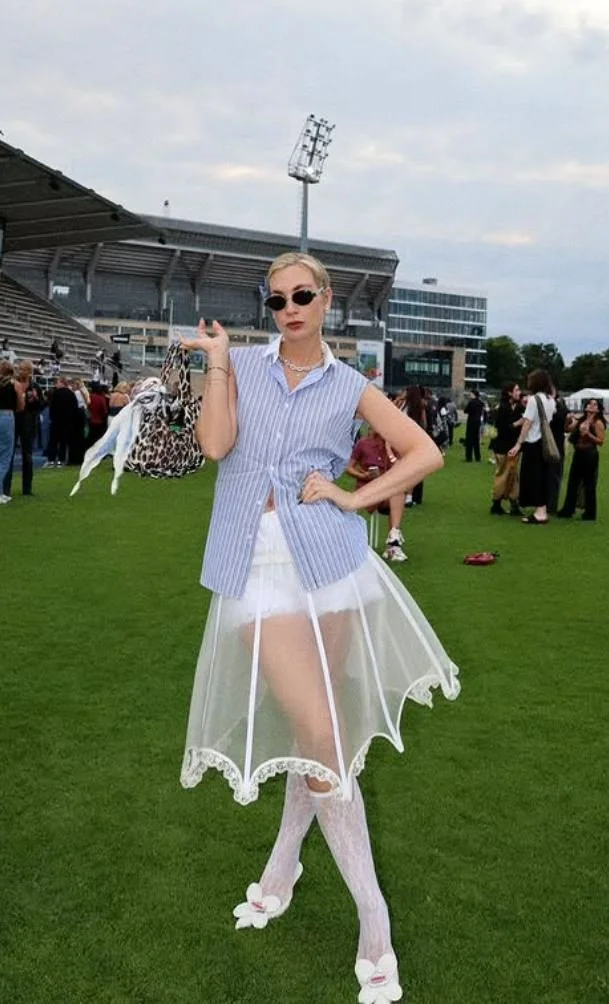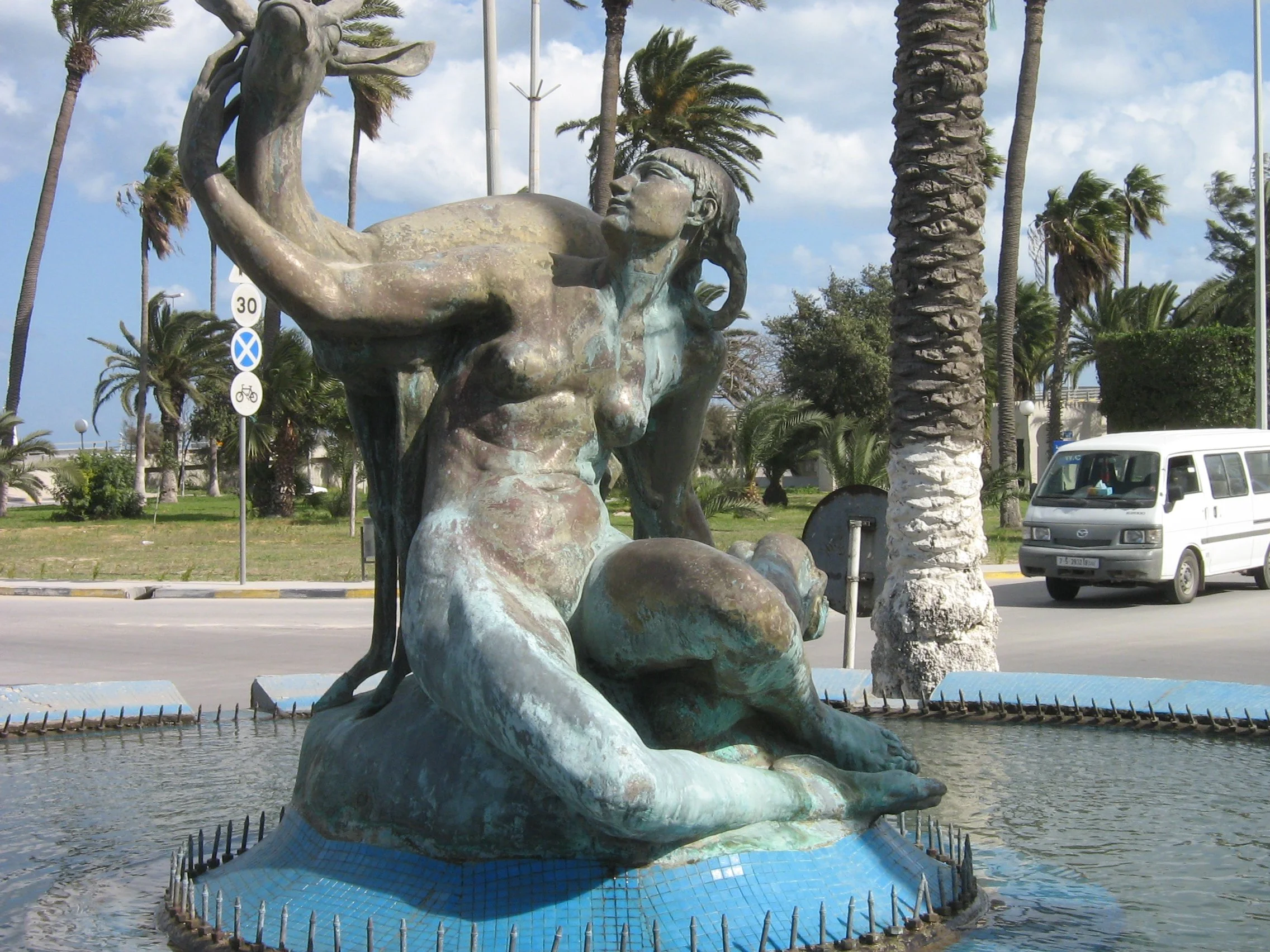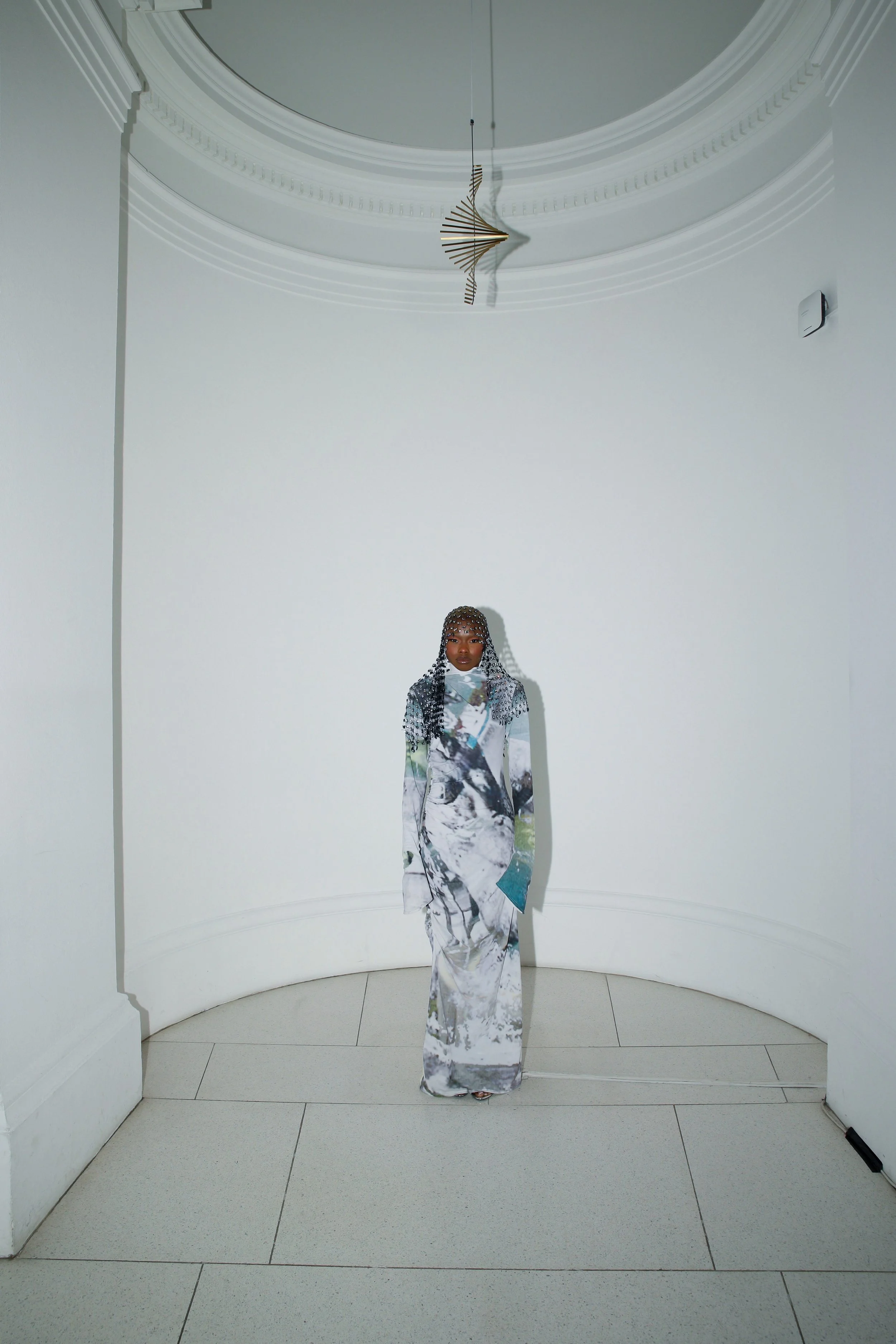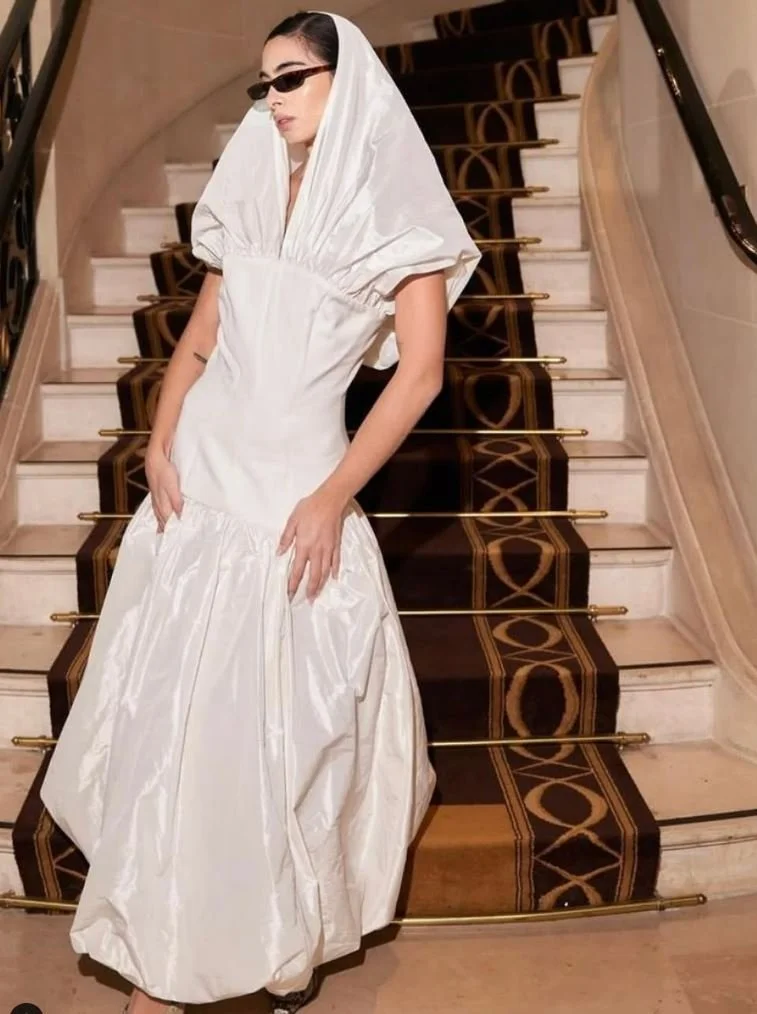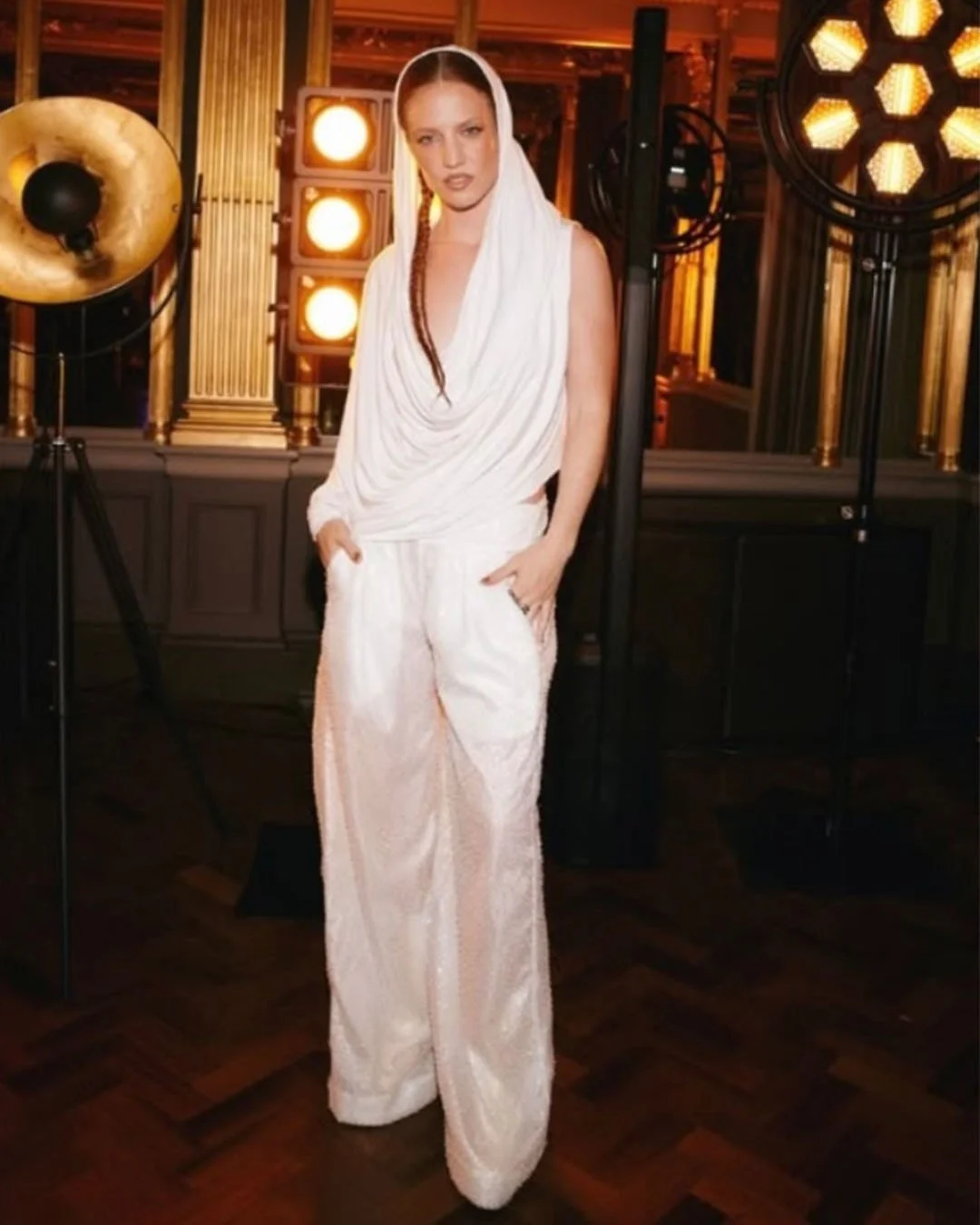The designer bringing Amazigh culture into fashion
Lilian Alexkaiser in Crinoline Skirt. Image credit: Instagram @ruaaelmansuri
The best part of writing TORN is getting to learn about cultures and histories that I was previously naive about, and my recent conversation with Ruaa Elmansuri was a wonderful lesson about Libyan fashion. The 27-year-old North-African fashion designer and researcher spoke to me about her collections that are inspired by her Amazigh heritage, and that have now been worn at fashion week parties by celebrities including Jess Glynne and Federica Labanca.
Born in Libya, Ruaa moved to London 10 years ago when she was 16 to do her higher education here. Ruaa went to London College of Fashion (LCF) to study fashion textiles where she specialised in print making, then attending Central Saint Martin’s (CSM) to study a Master’s of Research in the Arts. In 2023 Ruaa launched her eponymous fashion brand, which has since been featured in the publications Schon, Rollacoaster and L’Officiel Brasil. It is clear in her work that Ruaa has a strong understanding of fashion and art both practically and theoretically, as her designs are not only technically beautiful but they also hold and represent strong meaning and purpose from North African culture and history.
I asked Ruaa what is was like incorporating her Amazigh heritage into her projects at a British university where, I am assuming, not many students or lecturers would be aware of her heritage. Her response was wonderful: “It was quite fun…in my foundation we had a project where I had to present and it was easy because no-one knew anything about it anyway. It was fun to explore the culture, and it was also good for me to research and start learning more about it, contacting people back home and asking for resources.”
For those reading this who, like me, are not very knowledgeable about Amazigh history, here is a short paragraph of information that I found while researching for this article. Amazigh refers to those indigenous of North Africa, specifically the Maghreb region which encompasses Libya, Morocco, Algeria, Tunisia and sections of other neighbouring countries. The Amazigh predate the arrival of Arabs in the region, who in the 7th and 8th centuries supressed the Amazigh kingdoms and began a process of cultural and linguistic assimilation known as ‘Arabization’. The Amazigh are known for their pottery and jewellery making, a famous Amazigh potter is Said, a ninth-generation potter from Morocco who, with his son, is keeping the ancient craft alive. Since the turn of the 21st century, those of Amazigh heritage have been advocating for more political recognition and representation. In some North African countries governments are now declaring Tamazight, the native Amazigh language, an official language.
A name that will stand out to anyone looking at the Ruaa Elmansuri website is the ‘Gazelle and the Beauty’ dress. But where does that name even come from? Well, there is more behind that question than you may think. “There’s a sculpture in the city that I grew up in [Tripoli], it was like a fountain. It was an area that everyone would go to and take pictures, and then 10 years ago it disappeared.”
Image Credit: Wikimedia Commons
The sculpture was an iconic one of a naked woman caressing a gazelle, and it was erected in 1932 during the Italian colonisation of Libya. In 2014 the sculpture went missing: “It was quite interesting at that time because some people had opinions against it…throughout the last century the idea of it kept changing; being admired, being shamed and being related to colonisation, some people did not like the fact that it was a naked body, it was so many opinions. Then it suddenly disappeared.”
The statue is yet to be found, and its disappearance remains a mystery: “I thought it would be interesting to incorporate it because it is still frustrating that no-one did anything about it.” The dress, made from a digitally printed stretch jersey fabric, is an abstract print of the gazelle statue, showcasing Ruaa’s printing skills that she perfected during her undergraduate collections: “I made a collage of pictures of the fountain and put it on a dress, a scarf and a glove as well.”
‘Gazelle and the Beauty’ dress and diamanté veil. Image Credit: @parosaroid
To me the most exciting part of Ruaa’s collections is that the clothes are mostly made from deadstock materials (surplus materials) from her previous work, from family members and from deadstock stores around London. Ruaa shared with me that she is currently working on a new collection, and that she has “sourced some fabrics from family members and some of their traditional outfits that they have not worn for years.” Most of Ruaa’s family live in Libya, but her siblings also live in the UK.
Using deadstock materials is the most sustainable way of making new clothes, and Ruaa is not the only designer doing it. Belgian based designer Celine Van den Bossche has been using deadstock materials in her designs for her brand Janue since 2019, and the non-binary fashion brand STHLM MISC is not only known for disrupting gender norms and being a loud voice in feminist and queer politics, they also make their clothes in Stockholm using deadstock materials.
I am going to make a prediction that Ruaa will become known for her beautiful head garments, as these are the pieces that stand out the most in her collections. Singer Jess Glynne wore the beaded trousers and hooded top to British Vogue’s and Rabanne’s LFW party, and fashion expert Federica Labanca wore the ivory hooded taffeta gown at Paris Fahion Week. The taffeta gown, finely tailored with a unique ethereal shape stands out in Ruaa’s collections. The wide hood of the dress creates an inverted triangle shape whilst the corset cinches the waist and elongates the torso thanks to its unusual length. It is a shape of dress that is rare to come across, and it perfectly sculpts the body whilst maintaining an elegant modesty. As a relatively small fashion designer, I was curious what Ruaa’s reactions were when she found out that celebrities were wearing her designs to fashion weeks. “It is really surreal because a few years ago I wouldn’t even think about that, so it is quite nice.”
Ruaa garnered inspiration for the head pieces from a Farashia, a traditional Libyan outfit worn by women that is made from white silk which covers the entire body and face, with only the eyes exposed. It is much less common to see women wearing Farashia’s in Libya today, but Ruaa wanted to incorporate the essence of the traditional outfit with a modern, more vague approach: “I am not making it that obvious or specific to a culture, I am trying to make clothes that are a bit unique”. One of the most exciting movements in fashion right now is removing the focus on Western ideals of beauty, and embracing and appreciating clothing from all corners of the world, which is exactly what Ruaa is doing here: “The garments are a mix of different cultures – they are quite traditional, but I tried to incorporate them to make them more accessible, so it is not just ‘this is a really traditional piece that is hard to wear, and you can only wear it for specific events only”.
Towards the end of our conversation Ruaa talks to me about her upcoming work: “At the moment I am working on a new collection with a jewellery artist who is also Libyan, she is based in London. Her name is Amani. I am like halfway there. There will be jewellery in this collection that will be inspired by Libyan jewellery.”
I for one cannot wait to see Ruaa’s next collaborative collection which I am certain will tell the stories of two Libyan artists who now live in the UK, and will have refreshingly new designs which will push the boundaries of expectations when it comes to silhouettes and modesty, and appeal to the majority whilst paying homage to their North African heritage.
